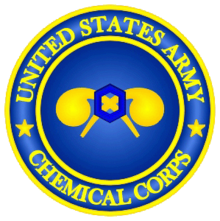Chemical Corps
| United States Army Chemical Corps | |
|---|---|

Seal of the Chemical Corps
|
|
| Active | 28 June 1918 - present |
| Country |
|
| Branch |
|
| Garrison/HQ | Fort Leonard Wood, Missouri |
| Website | U.S. Army CBRN School |
| Commanders | |
| Current commander |
Brigadier General James E. Bonner |
The Chemical Corps is the branch of the United States Army tasked with defending against chemical, biological, radiological, and nuclear (CBRN) weapons. The corps was founded as the U.S. Chemical Warfare Service (CWS) during World War I. Its name was changed to the Chemical Corps in 1946.
Discussion of the topic dates back to the American Civil War. A letter to the War Department dated 5 April 1862 from New York City resident John Doughty proposed the use of chlorine shells to drive the Confederate Army from its positions. Doughty included a detailed drawing of the shell with his letter. It is unknown how the military reacted to Doughty's proposal but the letter was unnoticed in a pile of old official documents until modern times. Another American, Forrest Shepherd, also proposed a chemical weapon attack against the Confederates. Shepherd's proposal involved hydrogen chloride, an attack that would have likely been non-lethal but may have succeeded in driving enemy soldiers from their positions. Shepherd was a well-known geologist at the time and his proposal was in the form of a letter directly to the White House.
The earliest predecessors to the United States Army Chemical Corps owe their existence to changes of military technology early in World War I. The United States War Department's first interest in providing individual soldiers with personal protection against chemical warfare came in 1915 and they tasked the Medical Department with developing the technology. Despite this early interest, troops were neither supplied with masks nor trained for offensive gas warfare until the U.S. became involved in World War I in 1917. By 1917, the use of chemical weapons by both the Allied and Central Powers had become commonplace along the Western, Eastern and Italian Fronts, occurring daily in some regions. In 1917, Secretary of the Interior Franklin K. Lane, directed the Bureau of Mines to assist the Army and Navy in creating a gas war program. After the Director of the Bureau of Mines formally offered the bureau's service to the Military Committee of the National Research Council, the council appointed a subcommittee on noxious gases.
...
Wikipedia
